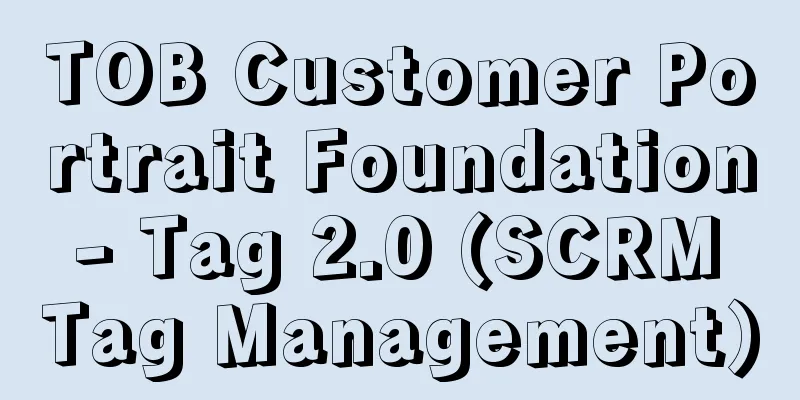TOB Customer Portrait Foundation - Tag 2.0 (SCRM Tag Management)

Abandon confused thinking and produce orderly content. The last time I talked about tags, I talked about the following:
other:
This time, let’s talk about some labels in scrm, mainly including channel labels (customer source channels, as long as the channel labels are scanned in, they can be automatically labeled), content labels (setting material labels, you can label after watching certain materials), and behavior labels (for example, participating in activities, forwarding articles, automatically labeled). Let’s talk about channel labels first. I divide channel labels into the following categories: 1. Channel-Activity: For a specific activity, you can analyze the activity publicity input; 2. Channel - Self-media: You don’t need to be specific about a certain article, just the general category of self-media will do, such as Zhihu, Toutiao, official accounts, etc. 3. Channel - Official website: The official website is the main channel for traffic, so official website detection is also very important. Many people in charge of SEM/SEO will analyze the source pages and suggest that companies select some important source pages and make them active separately, such as the actual traffic flow of a newly built landing page and the traffic flow of a key industry. If divided into more detailed categories, it can also be divided into the official website sidebar, banner, bottom, etc. 4. Channel-Poster: Marketing posters may involve a wide variety of content, such as sharing of practical white papers, introduction of functional points, holiday greetings, etc. 5. Channel-Others; Others are some miscellaneous content, including but not limited to ecological associations, email marketing, personal/departmental traffic, etc. It depends on the situation. For example, for this event, I want to divide it into very detailed categories, to know the traffic situation of some people, as well as the traffic situation of events jointly organized with ecological partners. It is set based on the necessary degree of analysis. Content tags are material tags. There is no need to divide them into very detailed categories. Our goal is to know what content customers are more interested in, so I divide them into the following categories: 1. Content-Industry: Industry classification that enterprises attach importance to. 2. Content-type; for example, this material is about function introduction, activities, interviews, cases, in-depth content, etc. 3. Content-others; for example, channel detection. If this article is placed in an email, I will mark it as email marketing. Another type is similar to behavioral labeling. For example, if a customer forwards an article, the system will detect it and automatically mark it as a forwarded article, etc. Behavior tags are both channel tags and content tags. It depends on the specific situation. Some customers may miss out on adding tags, so we will manually add tags after further understanding. Of course, I personally think that it is still necessary to control the number of tags. Many of them are the points of concern of content partners or event partners, but not the points of concern of operations personnel, so some tags do not need to be put. To give a simple example, such as event promotion, we may be very detailed when setting the event channel live code. What platform is the line in? This may be a point of concern for a certain partner in the team, but for operations personnel, they only need to know that he is here to participate in the event, so don't add the platform label when setting the live code. Specifically, the name of the channel active code is [xx activity-xxx platform], but the label in the channel active code needs to be [xx activity], and there is no need to set [xxx platform], because the operation partner does not need to know which specific ecological partner platform the call comes from. All customers who come in through all channels will be revisited uniformly. That’s the end of this article. The labeling is good and the customer management is great. I hope we can all go further and further on the road of customer operations! Public account: cici notes |
<<: To seize the opportunity of Xiaohongshu, you must seize the opportunity of store broadcasting
Recommend
Taobao Live Can’t Save Metersbonwe
As the times change, Metersbonwe (Metersbonwe), on...
Xiaohongshu high-quality delivery notes production standards
This article mainly introduces how to formulate hi...
From the 500 accounts with the fastest increase in followers, we can see the secret code for Xiaohongshu's "takeoff" in 2025
In the vast content ecosystem of Xiaohongshu, whic...
Is there a good prospect for cross-border e-commerce without source of goods? How to do it?
Is there a good prospect for cross-border e-commer...
Major coffee brands have entered the Douyin group buying market
This article introduces the new sales channels of ...
How much is the average Amazon sales commission? How can I get more commission?
Amazon is the most popular cross-border e-commerce...
It turns out that the Xiaohongshu account has no traffic because of this!
There are always many problems in operating Xiaoho...
Does Amazon Europe need VAT for self-delivery? Under what circumstances do I need to register for VAT?
If you want to open a store on Amazon Europe, you ...
Meituan-Kuaishou cooperation upgraded to "100 cities, 10,000 stores"
The cooperation upgrade between Kuaishou and Meitu...
Will Xiaohongshu change its direction again in the second half of 2024? How to sell goods in the e-commerce era!
As a platform integrating e-commerce and social me...
Can I get my deposit back for Shopee's activities? What are the advantages?
Everyone knows the Shopee platform. Now everyone w...
31 days after Douyin Supermarket was launched
Douyin Supermarket has been online for a month. Ho...
Entering commercialization 2.0, is Video Account still the last traffic pool?
This article deeply analyzes the nature of video a...
These 27 types of content on Video Account will be restricted, so don’t post them anymore!
Understanding what content will trigger these rest...
How to set up cash on delivery on Shopee? Frequently asked questions about cash on delivery
Generally speaking, people who shop on e-commerce ...









